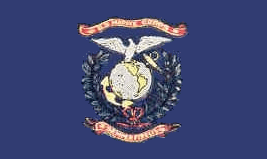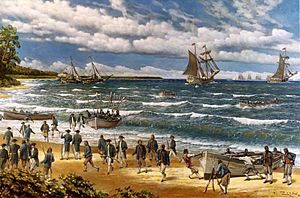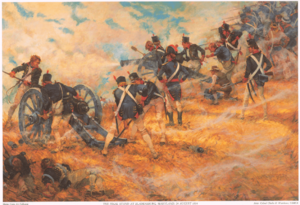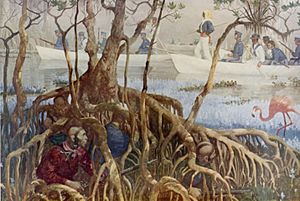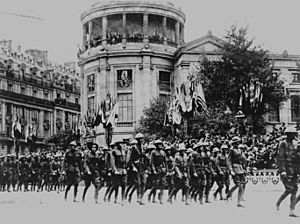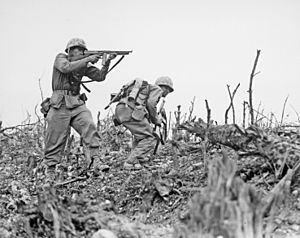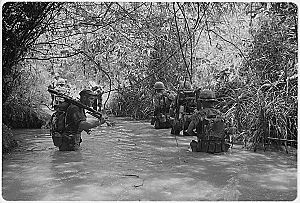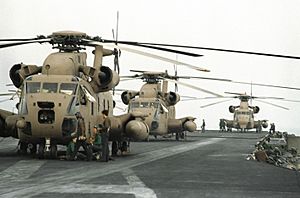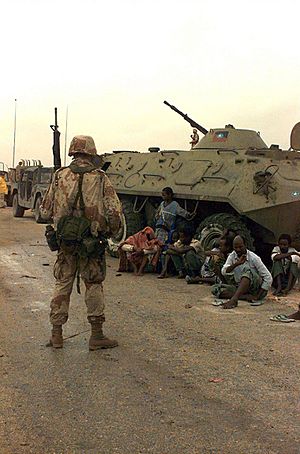History of the United States Marine Corps facts for kids
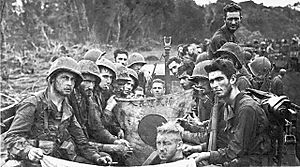
The history of the United States Marine Corps (USMC) is all about how this important part of the U.S. military came to be and what it has done. It started way back on November 10, 1775, with the Continental Marines. Their first jobs were fighting from ship to ship, keeping order on ships, and helping soldiers land on shore. Over time, their role changed as the United States grew and its foreign policy shifted.
Because Marines could be sent out quickly from ships, they have been involved in almost every conflict in U.S. history. They became super important during World War II because their ideas about amphibious warfare (landing troops from the sea onto an enemy-held coast) were exactly what was needed in the Pacific War. By the early 1900s, the Marine Corps was a leader in planning and carrying out these types of landings. Their ability to quickly respond to crises around the world has made them a key tool for U.S. foreign policy.
In February 1776, the Continental Marines went on their first big trip. After the American Revolutionary War, the Continental Marines were disbanded, just like the Continental Navy. But before the Quasi-War with France, the U.S. Congress decided to bring back the United States Navy and the Marine Corps.
One of the Marines' most famous actions from this early period was during the First Barbary War (1801–1805) against the Barbary pirates. Later, in the Mexican–American War (1846–1848), the Marines made a famous attack on Chapultepec Palace near Mexico City. This was their first big adventure far from home. In the 1850s, Marines served in Panama and Asia. During the American Civil War (1861–1865), the Marine Corps played a smaller role. Their main jobs were helping with the blockade and fighting on ships. They also took part in a few land operations as the war went on.
The rest of the 1800s was a time when the Marine Corps got smaller and thought a lot about what its main purpose should be. Under Commandant Jacob Zeilin (1864–1876), many important Marine customs and traditions were created. During the Spanish–American War (1898), Marines led U.S. forces ashore in the Philippines, Cuba, and Puerto Rico, showing they were ready to go anywhere. Between 1900 and 1916, the Marine Corps continued to go on foreign trips, especially in the Caribbean and Central and South America. This included places like Panama, Cuba, Veracruz, Haiti, Santo Domingo, and Nicaragua.
In World War I, experienced Marines played a key role when the United States joined the fight. Between the two World Wars, Major General John A. Lejeune led the Marine Corps. In World War II, the Marines were very important in the Pacific War, fighting in almost every major battle. The Corps grew huge, from two small groups to two large groups with six divisions and five air wings. During the Battle of Iwo Jima, photographer Joe Rosenthal took the famous photo Raising of the Flag on Iwo Jima, showing five Marines and one Navy medic raising a U.S. flag on Mount Suribachi.
The Korean War (1950–1953) saw the 1st Provisional Marine Brigade bravely hold the line at the Battle of Pusan Perimeter. This was also where Marine helicopters (from VMO-6 flying HO3S1 helicopters) were first used in combat. Marines also played a big part in the Vietnam War at battles like Da Nang, Huế, and Khe Sanh. They fought both small-scale Viet Cong attacks and bigger battles against North Vietnamese Army soldiers.
Marines went to Beirut during the 1982 Lebanon War on August 24, 1982. On October 23, 1983, the Marine barracks in Beirut was bombed. This caused the most deaths for the Corps during peacetime in its history. Marines were also key in freeing Kuwait during the Gulf War (1990–1991). The I Marine Expeditionary Force had 92,990 Marines, making Operation Desert Storm the largest Marine Corps operation ever.
Contents
How the Marines Began
The idea of "marines" goes way back to European naval wars in the 1600s and 1700s. Many European countries had naval forces. In 1664, England formed a special regiment called the "Maritime Regiment of Foot," which was the start of the modern Royal Marines. These soldiers were meant to fight on ships and help with landings.
By 1702, England had six maritime regiments fighting with the fleet against Spain. In 1704, these marines fought ashore in Gibraltar and Spain as part of a landing force. After wars ended, these marine regiments often disbanded or joined the regular army.
In 1739, a conflict called the War of Jenkins' Ear started against the Spanish Empire. The British government formed ten regiments of marines for a naval campaign in the West Indies. The British asked their American colonies to form a regiment of three thousand men for naval service. This regiment, known as ""Gooch's Marines"," is seen as a link to the start of the United States Marine Corps.
On November 10, 1775, the Second Continental Congress decided to create two marine battalions. This date is still celebrated as the official birthday of the U.S. Marine Corps. These American marines were meant to do the same jobs as the British marines.
Early American Marines
When the American Revolutionary War started in April 1775, American leaders realized they needed a navy to fight the British. Even though there wasn't a strong Continental Navy yet, individual colonies had their own navies and marines. Sometimes, soldiers from the Continental Army or militia groups served as marines on ships.
The first official commission for a Continental Marine officer was given to Captain Samuel Nicholas on November 28, 1775. Nicholas likely used his family's tavern as a place to recruit new Marines. Today, the legend says the first recruiting post was at Tun Tavern in Philadelphia.
In December 1775, Congress created the Marine Committee to help plan the Continental Navy and Marine Corps. This committee had members from each of the thirteen colonies. Congress wanted to send Marines to fight at sea and on land.
On February 17, 1776, the Continental Marines went on their first big trip with Commodore Esek Hopkins's fleet. This was the first amphibious operation for the Continental Navy-Marine Corps.
On March 3, 1776, the Continental Marines made their first official landing in American history during the Battle of Nassau in the Bahama Islands. They tried to surprise the British at Fort Montagu to get supplies, but the British were warned and moved most of their gunpowder. The Marines and sailors took cannons and other supplies before leaving.
On April 6, 1776, Marines and sailors fought in a naval battle off Long Island, New York. Lieutenant John Fitzpatrick was the first Continental Marine killed in combat.
In April 1776, John Martin became the first black American Marine. He served aboard the Continental brig Reprisal.
On September 5, 1776, the Marine Committee decided on a uniform for the Continental Marines. It was a short green coat with white trim, a high leather collar (which led to the nickname "leatherneck"), a white vest, white pants, and a black hat. The green color likely came from available cloth and helped tell them apart from the Army and Navy.

In late 1776, Major Samuel Nicholas and his Marines were sent to help General George Washington's army in New Jersey. This was the first time American Marines fought on land with the army. They joined a brigade of militia and helped defend a bridge during the Battle of the Assunpink Creek. On January 3, 1777, the Marines fought and died in battle for the first time at the Battle of Princeton.
After the war ended in 1783, both the Continental Navy and Marines were disbanded. Even though there was a gap before the modern Marine Corps was created, Marines still celebrate November 10, 1775, as their official birthday.
Modern Marine Corps Begins
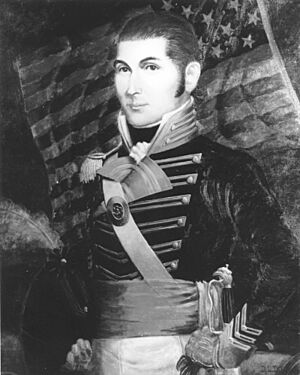
Because French ships were bothering U.S. shipping, Congress decided to create the United States Navy and the Marine Corps again. The U.S. Marine Corps was officially re-established on July 11, 1798, by President John Adams. The Corps was to have a battalion of 500 privates.
In 1801, President Thomas Jefferson and Major William Ward Burrows I (the first official Commandant) chose a place for a Marine barracks in Washington, D.C.. This place is still used today as Marine Barracks, Washington, D.C. Burrows also started the United States Marine Band, which has played at every presidential inauguration since 1801.
The Marines' most famous action in this period was in the First Barbary War (1801–1805) against the Barbary pirates. Lieutenant Presley O'Bannon led a small group of eight Marines and other fighters in an attempt to capture Tripoli. Even though they only reached Derne, this battle is remembered in the Marines' Hymn. The leader of Tripoli was so impressed that he gave a special sword to O'Bannon. Marine officers still carry a similar sword today.

In the War of 1812, Marines helped set up bases for the Navy on the Great Lakes. Marine ship detachments fought in important naval battles. Marines became known as excellent marksmen. They also fought on land, like at the Battle of Bladensburg, where they tried to slow down British forces marching toward Washington. Legend says the British respected their fighting so much that they spared the Marine Barracks when they burned Washington. At the Battle of New Orleans, Marines held the center of General Andrew Jackson's defense.
Henderson's Leadership
After the War of 1812, the Marine Corps faced tough times. But Archibald Henderson became the fifth Commandant in 1820 and brought new life to the Corps. He was the longest-serving commandant and is called the "Grand old man of the Marine Corps." Under his leadership, the Marine Corps became a force ready to go anywhere quickly.
Henderson made sure Marines were sent on many trips to places like the Caribbean, Gulf of Mexico, West Africa, and China. He also added artillery training for landing parties. Henderson also stopped attempts by President Andrew Jackson to combine the Marine Corps with the Army. Instead, Congress passed a law in 1834 that said the Corps was part of the Department of the Navy, just like the United States Navy.
When the Seminole Wars (1835–1842) started, Commandant Henderson volunteered the Marines for service. They fought in Florida and helped defend against Indian attacks.

Ten years later, in the Mexican–American War (1846–1848), the Marines made their famous attack on Chapultepec Palace, which overlooked Mexico City. This is remembered in the line "From the Halls of Montezuma" in the Marines' Hymn. The high number of officers and non-commissioned officers who died in this battle is honored by the "blood stripes" on the Marines' dress uniform. Marines also helped blockade Mexico and fought in California.
In the 1850s, Marines served in Panama and Asia. Two hundred Marines were among the first Americans to visit Japan with Matthew C. Perry's fleet.
Civil War
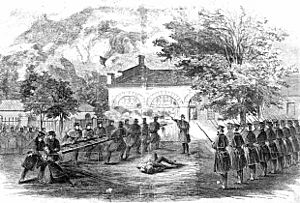
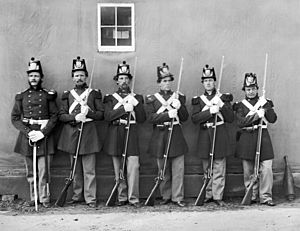
The Marine Corps played a smaller role in the American Civil War (1861–1865). Their main jobs were helping with the blockade and fighting on ships.
Before the war, a group of 86 Marines helped arrest John Brown at Harper's Ferry in 1859. They stormed the building where he was hiding.
At the start of the war, many Marine officers resigned to join the Confederacy. A group of Marines, mostly new recruits, were sent to the First Battle of Bull Run. While some reports said they performed poorly, others say they fought as well as other Union forces.
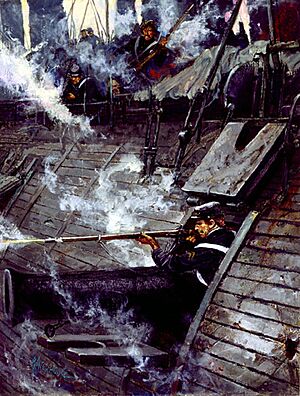
Congress did not greatly increase the size of the Marines during the war. Marines from ships and small groups took part in landings to capture bases for blockade duty. Corporal John F. Mackie became the first Marine to receive the Medal of Honor in 1862 for his bravery during the Battle of Drewry's Bluff.
In January 1865, Marines helped in the Second Battle of Fort Fisher. Five Marines earned the Medal of Honor during this battle. In total, 148 Marines died in the Civil War.
Late 1800s
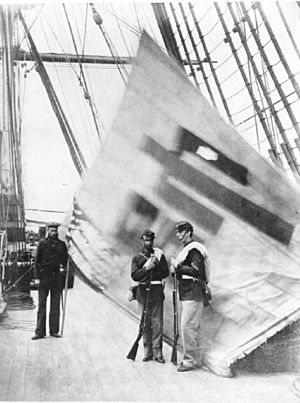
After the Civil War, the Marine Corps became smaller. The Navy was changing from sail to steam ships, which made people wonder if Marines were still needed on ships. However, Marines became useful for quick interventions and landings to protect American lives and property in other countries.
Marines were involved in over 28 separate interventions between the end of the Civil War and the end of the 1800s. This included places like China, Japan, Nicaragua, and Panama. In 1885, a writer named Richard Harding Davis made the phrase "The Marines have landed and have the situation well in hand" popular when describing American actions in Panama.
Under Commandant Jacob Zeilin (1864–1876), many Marine customs and traditions were created. The Corps adopted its emblem in 1868, which includes the globe, fouled anchor, and a U.S. bald eagle. In 1883, the Marines adopted their current motto "Semper Fidelis", which is Latin for "Always Faithful."
Spanish-American War
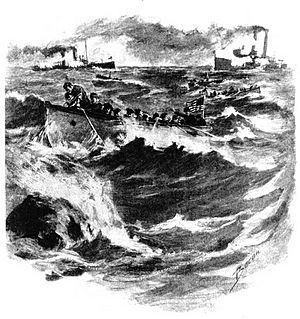
During the Spanish–American War (1898), Marines led U.S. forces ashore in the Philippines, Cuba, and Puerto Rico. At the Battle of Cienfuegos, Marines cut undersea telegraph cables under heavy Spanish fire. Twelve Marines earned the Medal of Honor for their bravery.
The 1st Battalion of Marines captured Guantánamo Bay to set up a base for the fleet. Sergeant John H. Quick received the Medal of Honor for bravely signaling a U.S. ship to shift its fire during a Spanish attack.
In the Philippines, Marines landed after the Battle of Manila Bay and fought in the Capture of Guam and Siege of Baler. In the later Philippine–American War, Marines served as peacekeepers. Fifteen Marines earned the Medal of Honor during these conflicts.
Early 1900s
The successful landing at Guantanamo and the Marines' readiness for the Spanish-American War showed their value. In 1900, the Navy decided the Marine Corps would be responsible for capturing and defending advanced naval bases. The Marine Corps formed a special battalion for expeditions, which practiced landings in 1902.
In November 1903, Marines stopped Colombian Army forces from crushing a Panamanian rebellion, which led to Panama's independence. Marines stayed in Panama until 1914.
Marine aviation began on May 22, 1912, when Lieutenant Alfred Austell Cunningham started training in aviation. By 1915, the Commandant allowed the creation of an aviation company.
Marines also played a role in China. They defended Western buildings in Peking during the Boxer Rebellion (1899–1901). The Boxers wanted to remove all foreigners from China. A small group of 56 Marines helped protect the foreigners until more forces arrived. Private Daniel Daly earned his first Medal of Honor here. The 4th Marine Regiment would later defend the Shanghai International Settlement in 1927.
Banana Wars
Between 1900 and 1916, the Marine Corps continued to go on foreign trips, especially in the Caribbean and Central and South America. These actions were called the "Banana Wars." Marines gained experience in fighting small rebellions during this time. Many of these actions were part of the Monroe Doctrine, which was the U.S. effort to prevent other countries from interfering in the Western Hemisphere.
Marines occupied Cuba from 1899 to 1902 and again from 1906 to 1909, and later. They also occupied Nicaragua from 1912 to 1933 to prevent the building of a canal without American control. They fought against Augusto César Sandino until their withdrawal in 1933.

Marines also returned to Mexico during the Mexican Revolution. They were sent to Veracruz in April 1914 to occupy it. Major Smedley Butler and his battalion from Panama joined the fight. Fifty-six Medals of Honor were given out, including Butler's first.
Marines were involved in the Dominican Republic in 1903, 1904, and 1914, and then occupied it from 1916 until 1924. They fought against local resistance until 1921.
The Marines also occupied Haiti from July 28, 1915, until August 1, 1934. Major Butler led Marines to capture Fort Riviere, a stronghold. During this nineteen-year occupation, eight Marines earned the Medal of Honor, including the second awards to Gunnery Sergeant Dan Daly and Major Butler, who are the only Marines to receive two Medals of Honor.
Marine Aviators started trying out air-ground tactics during the Banana Wars. They focused on supporting their fellow Marines on the ground. They developed the tactic of dive bombing in Haiti and perfected it in Nicaragua.
World War I
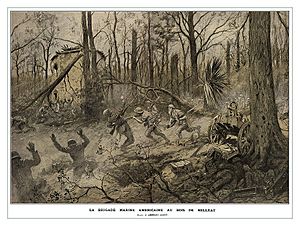
In World War I, Marines played a limited but important role. Unlike most Allied armies, the Marine Corps had many experienced officers and non-commissioned officers. Its most famous action was the Battle of Belleau Wood from June 1 to 26, 1918. Marines fought fiercely, driving German forces out of the area. Their toughness earned them the respect of the Germans.
The French government renamed the forest "Bois de la Brigade de Marine" ("Wood of the Marine Brigade") and honored the 5th and 6th Regiments. This allowed them to wear the fourragère on their uniforms. Marine aviation also grew, with squadrons deploying to hunt German submarines and provide bomber and fighter support in France.
Near the end of the war, Marines were sent to Vladivostok in Russia to protect American citizens during the Russian Civil War.
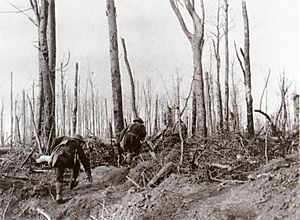
Opha May Johnson was the first woman to join the Marines in 1918 during World War I. By the end of the war, 305 women had enlisted. The Marine Corps grew significantly during the war, with 2,461 Marines killed and 9,520 wounded. Eight Marines earned the Medal of Honor.
A New Mission: Amphibious Warfare
Between the World Wars, Major General John A. Lejeune led the Marine Corps. The Marines were looking for a new main job after World War I. They found it: becoming a fast-reacting, light infantry force that could be quickly carried by the Navy to distant places. Their special role would be amphibious landings on enemy-held islands.
In 1921, Major "Pete" Ellis wrote a secret plan called "Advanced Base Operations in Micronesia." He predicted that to win a war in the Pacific, the Navy would need to land Marines to capture islands, which would then become forward bases. Ellis said that successful landings would need fast assault boats, strong naval gunfire, and air support. He also predicted that the Japanese would have to spread out their forces to defend many islands, not knowing which one the Americans would attack.

It took another ten years to put this plan into action. New types of ships were needed to land troops on beaches without huge losses. In 1941, British and American ship designers created the "landing ship" (like the LST), which could carry infantry, tanks, and supplies directly onto beaches.
In 1933, a "Fleet Marine Force" was created specifically for amphibious landings. This force included Marine aviation units that trained in observation and ground support. By 1940, the Marine Corps had developed its plan for amphibious assaults. Under the leadership of General Holland "Howlin Mad" Smith, the Marines were ready for combat.
World War II
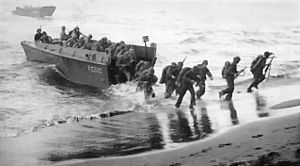
In World War II, the Marines were very important in the Pacific War, fighting in almost every major battle. The Corps grew to its largest size ever, with over 475,000 Marines. Battles like Guadalcanal, Tarawa, Saipan, Iwo Jima, and Okinawa saw intense fighting between U.S. Marines and the Japanese Army. The secret Navajo code talker program helped the Marines succeed by providing secure communications. In 1942, the first African American recruits were accepted into the Corps.
During the battle for Iwo Jima, photographer Joe Rosenthal took the famous photo Raising of the Flag on Iwo Jima. Secretary of the Navy James Forrestal said of the flag raising, "...the raising of that flag on Suribachi means a Marine Corps for the next five hundred years." The Marines' actions in the war greatly increased their reputation.
Marine aviation also grew a lot during the war. The Battle of Guadalcanal taught important lessons about needing air superiority and quickly getting airfields during landings. Marines also developed ways to coordinate air support with ground troops.
Most Marines served in the Pacific, but some were in the European Theater, North Africa, and Middle East, mostly on warships or guarding naval bases.
By the end of the war, 19,733 Marines had been killed and 68,207 wounded. Eighty-two Marines received the Medal of Honor. Marine Aviators shot down 2,355 Japanese aircraft.
After World War II
After the war, the Marine Corps faced challenges. Some in the military wanted to combine the Marines' jobs with the Navy and Army. But the Marine Corps fought back and got legal protection in the National Security Act of 1947. Despite this, the Marines faced big budget cuts and became much smaller.
However, women were included in the Women's Armed Services Integration Act in 1948, giving them permanent status in the Marines.
President Harry S. Truman was not a big fan of the Marines and tried to cut their budget. He even tried to stop the Commandant from attending important military meetings. But when these cuts led to a military that was too weak at the start of the Korean War, the Secretary of Defense resigned. Ironically, the Marines played a key role in an amphibious operation at Inchon at the start of the Korean War.
In 1952, a new law gave the Commandant an equal voice with the Joint Chiefs of Staff. This also set up the structure of three divisions and air wings that the Corps still uses today. This allowed the Marines to keep a division and air wing in the Far East and participate in smaller conflicts.
Marine aviation also improved with jet aircraft and helicopters. Helicopters were developed to allow for more spread-out attacks on enemy shores, a concept called "vertical envelopment."
Korean War
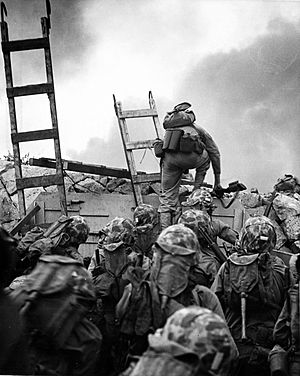
The Korean War (1950–1953) saw the quickly formed 1st Provisional Marine Brigade hold the line at the Battle of Pusan Perimeter. Marine helicopters were used in combat for the first time here. General Douglas MacArthur asked for Marine air and ground forces to make an amphibious landing at the Battle of Inchon. This successful landing caused North Korean forces to collapse.
Later, Chinese troops entered the war and surrounded U.S. forces. Unlike the Army, the 1st Marine Division fought its way back to the coast, causing heavy losses to the Chinese. This became known as the Battle of Chosin Reservoir and is a famous example of Marine toughness. Marines continued to fight around the 38th Parallel until the war ended in 1953.
The Marine Corps grew from about 75,000 Marines at the start of the war to 261,000 by the end. Four thousand two hundred sixty-seven Marines were killed and 23,744 wounded. Forty-two Marines received the Medal of Honor.
Between Wars
In the years after the Korean War, Marines continued to be sent to regional crises. In 1956, Marines evacuated Americans from Alexandria during the Suez Crisis. In 1958, Marines went to Lebanon. Marines also returned to Cuba from 1959 to 1960 to protect Americans during the Cuban Revolution.
Marines returned to Santo Domingo in the Dominican Republic in April 1965. They were sent to evacuate Americans during fighting and later to prevent a second Communist nation in the area. Marines quickly forced a cease-fire.
Vietnam War
The Marines played a very important role in the Vietnam War at battles like Da Nang, Huế, and Khe Sanh. They fought both a constant small-scale war against the Viet Cong and bigger battles against North Vietnamese Army regulars. Marines also used special techniques for fighting rebellions.
The Marine presence was pulled out in 1971, but they returned briefly in 1975 to evacuate Saigon and rescue the crew of the Mayagüez. Thirteen thousand ninety-one Marines were killed and 88,594 wounded during the war. Fifty-eight Marines were awarded the Medal of Honor.
After Vietnam
After the Vietnam War, the Marine Corps faced some difficult times with high rates of problems like desertion. But they worked to improve the quality of new recruits and strengthen their non-commissioned officer corps. The Marine Corps then went back to its role as an expeditionary force.
In 1979, students in Tehran stormed the U.S. Embassy and took 53 hostages, including the Marine Security Guards. Marine helicopter pilots took part in Operation Eagle Claw, a rescue attempt in 1980 that faced unexpected problems and failed. This mission showed the need for aircraft that could take off and land vertically but fly faster than helicopters, leading to the development of the V-22 Osprey.
Marines returned to Beirut during the 1982 Lebanon War in August 1982 as part of a multinational peacekeeping force. On October 23, 1983, the Marine barracks in Beirut was bombed. This caused the highest number of peacetime deaths for the Corps: 220 Marines, 18 sailors, and three soldiers. As violence increased, the Marines were ordered to leave in February 1984.
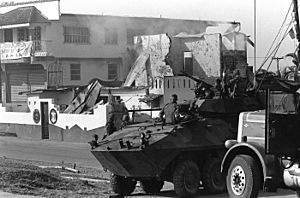
Marines then had a series of successes. The Invasion of Grenada began in October 1983 to respond to a coup. Marines quickly took the northern areas. In December 1989, Marines were sent to the Philippines to protect the U.S. Embassy during a coup attempt. The Invasion of Panama began in December 1989 to remove the dictator Manuel Noriega.
The 1990s
Gulf War
Marines were key in freeing Kuwait during the Persian Gulf War of 1990 and 1991. The I Marine Expeditionary Force had 92,990 Marines, making it the largest Marine Corps operation in history. Twenty-four Marines were killed in action, and 92 were wounded.
Bosnian War
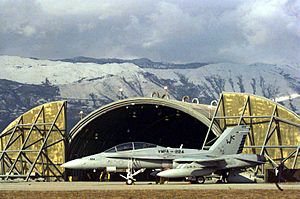
Marines played a role in the Bosnian War. Operation Deny Flight began in April 1993 to enforce a no-fly zone and provide air support. In 1995, a bombing campaign began. In June 1995, an Air Force pilot was shot down, and Marines rescued him from western Bosnia. Marines also supported peacekeeping forces until 1999.
Other Operations
In 1990, Marines conducted Operation Sharp Edge to evacuate Americans from the civil war in Liberia. They evacuated hundreds of civilians. Marines returned in 1996 for Operation Assured Response to help evacuate more people. In 1998, Marines were deployed to Albania to provide security to the American Embassy. In 1999, Marines were sent to East Timor to help with the end of its occupation.
Marines also took part in combat operations in Somalia (1992–1995) during Operations Restore Hope and United Shield. While these were meant for humanitarian relief, Marines often fought against Somali militiamen.
Twenty-first Century
After the September 11 attacks in 2001, U.S. President George W. Bush announced the War on Terrorism. The Marine Corps has been involved in operations around the world to fight terrorist groups.
In 2002, a task force was set up in Djibouti to provide regional security in the Horn of Africa. Marines continued to operate there into 2010. In 2006, Marines evacuated Americans from Lebanon and Israel during fighting. In 2010, Marines returned to Haiti after a major earthquake as part of Operation Unified Response.
War in Afghanistan
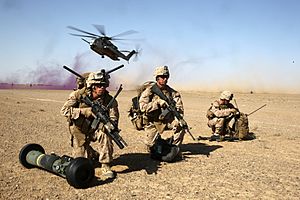
After the attacks on September 11, 2001, Marines and other U.S. forces began preparing for Operation Enduring Freedom in Afghanistan. Marine units have been rotating through Afghanistan, fighting Taliban and Al-Qaeda forces. In June 2009, 7,000 Marines deployed to Afghanistan to improve security and began Operation Strike of the Sword. So far, 449 Marines have been reported killed in Afghanistan.
Iraq War
Marines played a big role in the Iraq War as part of Operation Iraqi Freedom. The I Marine Expeditionary Force, along with the Army's 3rd Infantry Division, led the invasion and received a special award. Marines left Iraq in late 2003 but returned for occupation duty in 2004. They were given responsibility for the Al Anbar Province, a large desert region.
During this time, Marines led two major attacks on the city of Fallujah in 2004. They also saw intense fighting in other places like Ramadi. The level of violence later decreased. On March 1, 2009, President Barack Obama announced that combat troops would withdraw by August 2010. The Marine Corps officially ended its role in Iraq on January 23, 2010. One thousand twenty-two Marines were killed in the war, and 8,623 were wounded.
Images for kids
-
Lieutenant Presley O'Bannon at Derna, April 1805.


